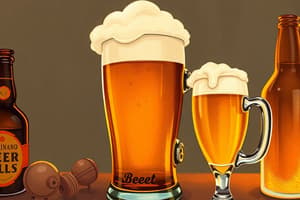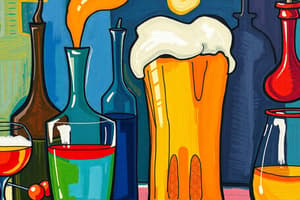Podcast
Questions and Answers
Rum is typically made from fermented grains.
Rum is typically made from fermented grains.
False (B)
All types of whiskey are made from bourbon.
All types of whiskey are made from bourbon.
False (B)
Liqueurs are typically sweet and flavored spirits.
Liqueurs are typically sweet and flavored spirits.
True (A)
Gin is a type of whiskey.
Gin is a type of whiskey.
Aperitifs are typically served after meals.
Aperitifs are typically served after meals.
What is the chemical formula of ethanol?
What is the chemical formula of ethanol?
At what temperature does ethanol boil?
At what temperature does ethanol boil?
What is the effect of ethanol on the brain and muscles?
What is the effect of ethanol on the brain and muscles?
What is a long-term effect of excessive ethanol consumption on the liver?
What is a long-term effect of excessive ethanol consumption on the liver?
Where is ethanol primarily absorbed in the digestive system?
Where is ethanol primarily absorbed in the digestive system?
What is the primary organ responsible for metabolizing ethanol?
What is the primary organ responsible for metabolizing ethanol?
What is the unit of measurement for Blood Alcohol Concentration (BAC)?
What is the unit of measurement for Blood Alcohol Concentration (BAC)?
What is the typical legal limit for BAC while driving?
What is the typical legal limit for BAC while driving?
What is the effect of a BAC of 0.30-0.40%?
What is the effect of a BAC of 0.30-0.40%?
Flashcards are hidden until you start studying
Study Notes
Types of Alcoholic Beverages
Beer
- Fermented from grains (barley, wheat, rice, corn)
- Typically 4-6% ABV (alcohol by volume)
- Styles: lager, ale, stout, porter, IPA
Wine
- Fermented from grapes or other fruits
- Typically 12-14% ABV
- Types: red, white, sparkling, dessert, fortified
Spirits
- Distilled from fermented grains, fruits, or vegetables
- Typically 35-50% ABV
- Types:
- Whiskey (bourbon, scotch, Irish)
- Vodka (grain or potato-based)
- Rum (sugarcane-based)
- Gin (juniper-flavored)
- Tequila (agave-based)
- Brandy (grape-based)
Liqueurs and Cordials
- Sweet, flavored spirits
- Typically 15-30% ABV
- Examples: Kahlúa, Baileys Irish Cream, Grand Marnier
Aperitifs and Digestifs
- Low-alcohol drinks served before or after meals
- Examples: Campari, Vermouth, Limoncello
Alcoholic Beverages
Beer
- Fermentation occurs from grains such as barley, wheat, rice, and corn
- Typically contains 4-6% ABV (alcohol by volume)
- Various styles include lager, ale, stout, porter, and IPA
Wine
- Fermentation occurs from grapes or other fruits
- Typically contains 12-14% ABV
- Classified into red, white, sparkling, dessert, and fortified types
Spirits
- Produced through distillation of fermented grains, fruits, or vegetables
- Typically contains 35-50% ABV
- Types include whiskey (bourbon, scotch, Irish), vodka (grain or potato-based), rum (sugarcane-based), gin (juniper-flavored), tequila (agave-based), and brandy (grape-based)
Liqueurs and Cordials
- Sweet and flavored spirits
- Typically contains 15-30% ABV
- Examples include Kahlúa, Baileys Irish Cream, and Grand Marnier
Aperitifs and Digestifs
- Low-alcohol drinks served before or after meals
- Examples include Campari, Vermouth, and Limoncello
Physical and Chemical Properties
- Ethanol has a chemical formula of C2H5OH and a molecular weight of 46.07 g/mol.
- It has a boiling point of 78.29°C (173.12°F) and a melting point of -114.3°C (-173.7°F).
- Ethanol has a density of 0.789 g/cm³ and is soluble in water, ethanol, and many organic solvents.
Effects on the Body
- Ethanol is a depressant that slows down brain activity, relaxes muscles, and impairs judgment.
- Short-term effects of ethanol consumption include impaired coordination, balance, and reaction time, as well as drowsiness, confusion, and nausea.
- Long-term effects of ethanol consumption can lead to liver damage and cirrhosis, brain damage and cognitive impairment, and increased risk of cancer, heart disease, and stroke.
Metabolism and Absorption
- Ethanol is absorbed through the digestive system, primarily in the small intestine.
- The liver metabolizes ethanol, converting it to acetaldehyde and then acetic acid.
- Ethanol is excreted through urine, sweat, and breath, with the rate of metabolism varying among individuals.
- Factors influencing ethanol metabolism include genetics, diet, and liver function.
Blood Alcohol Concentration (BAC)
- BAC is measured in grams per deciliter (g/dL) or milligrams per milliliter (mg/mL).
- Legal BAC limits vary by country and jurisdiction, but are generally around 0.08% (80 mg/dL) for driving.
- Effects of BAC on the body include:
- Relaxation and euphoria at 0.02-0.05% BAC
- Impaired judgment, coordination, and reaction time at 0.05-0.08% BAC
- Slurred speech, staggering, and dizziness at 0.08-0.15% BAC
- Confusion, disorientation, and vomiting at 0.15-0.30% BAC
- Stupor and loss of consciousness at 0.30-0.40% BAC
- Coma, respiratory depression, and death at >0.40% BAC
Studying That Suits You
Use AI to generate personalized quizzes and flashcards to suit your learning preferences.




